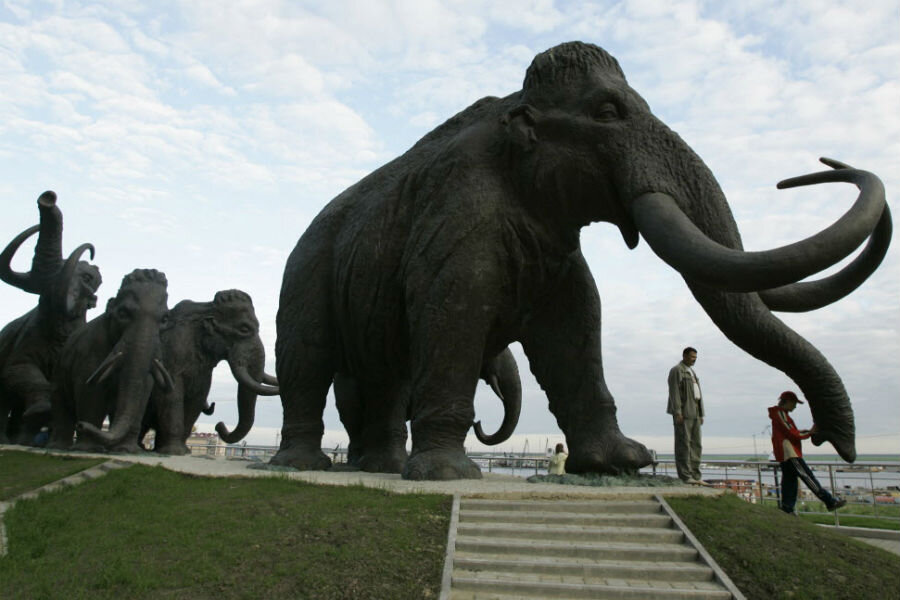Why bringing back extinct species may not help conservation efforts
Loading...
It's only a matter of time, scientists say, before we're able to bring extinct species back from the dead.
The real question now: should we?
Last week, a team of Harvard researchers announced they were on the brink of creating a hybrid woolly mammoth-elephant embryo, the next step on the long road to resurrecting the prehistoric creatures. As we move steadily closer to being able to bring extinct species – or something closely resembling them – to life through genetic engineering, some scientists say the technology could prove a valuable, much-needed conservation tool.
But a new economic analysis suggests that bringing back extinct species may detract from, rather than add to, conservation efforts.
"Given this atmosphere of a biodiversity crisis and limited resources, we really need to do the best job we possibly can," says Joseph Bennett, a biologist at Carleton University in Ottawa and lead author of the study. "If de-extinction represents a gain in biodiversity, that’s great. If it represents a Pyrrhic victory in that we could have better spent those resources to save species on their way to extinction, that's essentially a one step forward, two steps back scenario."
The study, published Monday in the journal Nature Ecology and Evolution, used data from New South Wales, Australia, and New Zealand to consider the cost of sustaining de-extincted populations under two scenarios. In the first scenario, a private agency funds the resurrection of an extinct species, then hands the responsibility of caring for the revived population over to the government. In the second, a private agency pays for the entire project, covering the costs of both resurrection and maintenance.
The results, researchers found, didn't bode well for endangered, living species. Under the first scenario, the cost of maintaining the de-extincted species was taken directly from the government's already limited conservation budget, resulting in an overall loss for biodiversity: Roughly two species would go extinct for every one resurrected, the team concluded. The second scenario produced a small increase in biodiversity, particularly for species that would require the same conservation tools and techniques already being used to protect endangered animals.
But the greatest hypothetical gains for biodiversity, the study said, came when the money required for de-extinction was instead put toward existing conservation programs for living species. In this scenario, roughly two to eight times more species were saved.
In other words, Professor Bennett tells The Christian Science Monitor in a phone interview, "it makes sense to spend money on the living rather than the dead."
Bennett and his team aren't the first to question whether de-extinction would help or hurt conservation efforts. Other scientists have argued that harnessing the technology to bring back extinct species, or something closely resembling them, could take away momentum from the push to protect endangered animals and give property developers an excuse to build over their natural habitats.
"De-extinction just provides the ultimate 'out,' " said wildlife biologist Stanley Temple in a 2015 BBC interview. "If you can always bring the species back later, it undermines the urgency about preventing extinctions."
But others see potential for saving endangered species in bringing back extinct ones, and say they don't believe funding for de-extinction and conservation are mutually exclusive.
"There are certain donors that are only interested in the biotechnology involved in de-extinction, and contrary there are certain donors that ... instead chose to donate to extant endangered species after their introduction," said Ben Novak, lead researcher with Revive & Restore, a foundation that researches genetic tools to conserve endangered and extinct species.
Furthermore, he told Popular Science, "de-extinct proxies offer the potential to raise more money for conservation than many extant species." For example, Mr. Novak said, an extinct animal could attract more visitors to a zoo.
Another potential benefit of developing de-extinction technology, some supporters say, is that it could produce new techniques and insights to help preserve existing species.
Professor Bennett acknowledges that scientists could likely learn a thing or two from studying extinct creatures. But, he points out, many of the same lessons could be learned – at a lower cost – using animals living today.
Ultimately, says Ronald Sandler, director of the Ethics Institute at Northeastern University, analyzing the pros and cons of de-extinction varies from species to species. When framing a cost-benefit analysis in terms of conservation, he tells the Monitor in a phone interview, "it’s almost never going to be the case that the benefits favor engaging in de-extinction."
However, Professor Sandler notes, conservation isn't the only driving force behind reviving extinct species like the woolly mammoth.
"In the case of de-extinction, the most prominent arguments for it do not appeal to its being a cost-effective conservation strategy," he writes in an editorial for Nature Ecology and Evolution. Some species, he tells the Monitor, have "symbolic value" or are "culturally important."
And some scientists are motivated by the scientific and technical value of the research – not the desire to create a conservation tool – while others view it as a way to "undo the harm" done by mankind in causing a species to go extinct in the first place.
"There are other reasons why people want to [restore] species besides conservation," Sandler says. "Cost-benefit analyses don't capture all the value that a species can have."






